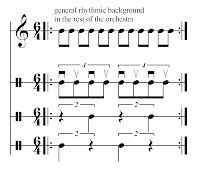I posted this on Facebook, and my college friend Matt jokingly (?) suggested I transcribe the duck sounds. So I thought why not? It didn't take long to realize that the duck isn't quacking randomly. It's almost a sort of Morse code, with short and long notes:
I used a sort of inflected 4/4 time because it's convenient. The measures of "1/16" could be notated as ritards, perhaps, but I like trying to keep it steady. That feels a little more honest.
I actually took two videos today; the other is pretty similar:
This is far from my area of expertise, but there seems to be some sort of pattern. Is this related to what a duck learns as a duckling, expressing hunger? Or is it simply "Look at this chump with a camera phone. Let's scam some stale bread out of him!" (For the record: I do NOT feed the ducks. I'm a good citizen.)
I actually took two videos today; the other is pretty similar:
This is far from my area of expertise, but there seems to be some sort of pattern. Is this related to what a duck learns as a duckling, expressing hunger? Or is it simply "Look at this chump with a camera phone. Let's scam some stale bread out of him!" (For the record: I do NOT feed the ducks. I'm a good citizen.)




















